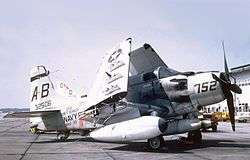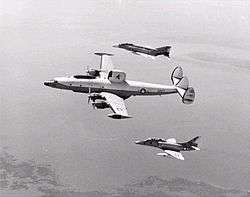VAQ-33
| Electronic warfare squadron | |
|---|---|
|
VAQ-33 squadron patch | |
| Active | 1949-1 October 1993 |
| Country | United States |
| Branch | United States Navy |
| Role | Electronic warfare aircraft |
| Part of | Inactive |
| Nickname(s) | Firebirds |
| Engagements |
Korean War Vietnam War |
%2C_USA_-_Navy_AN1040640.jpg)

VAQ-33, nicknamed the Firebirds, was a Tactical Electronic Warfare Squadron of the U.S. Navy, serving for 44 years (1949-1993) under various designations and with a constantly-evolving group of aircraft. It was designated VAQ-33 in 1968, at which time it operated the piston-powered EA-1F Skyraider, or Spad. The squadron had the distinctions of being the last Navy unit to operate the Skyraider, and of making its last carrier deployment, in 1969. The retirement of the Spad marked the beginning of the squadron's decades-long role as a pioneering electronic aggressor squadron. That role ended with electronic aggressor mission's being transferred to the Navy Reserve and the squadron's disestablishment at NAS Key West on 1 October 1993.[1]
History
The squadron was established in 1949 as Composite Squadron VC-33 at NAS Norfolk. It flew the TBM-3E/N/Q Avenger and a few SNB-5 Texans. Its mission was antisubmarine warfare (ASW). It moved to NAS Atlantic City in 1950, where its mission changed to night attack. It sent three detachments to the Korean War aboard carriers, where it distinguished itself in night attack and ECM missions.[1]
In 1952, it adopted the nickname Nighthawks, and in 1956 was redesignated as an All-Weather Attack Squadron VA(AW)-33. In 1958, the squadron moved to NAS Quonset Point, and was soon redesignated Carrier Airborne Early Warning Squadron VAW-33. In 1961, it began providing ASW detachments to antisubmarine carriers in the Atlantic Fleet. In 1966, a VAW-33 detachment supported the recovery of the Gemini IX spacecraft. From 1967-1968, VAW-33 provided carrier-based ECM services in the Vietnam War zone.[1]
Returning to NAS Norfolk in 1970, the squadron, now designated VAQ-33, adopted the Firebirds nickname, and came under operational control of the Fleet Electronic Warfare Support Group. Its new mission was to simulate electronic threats to units of the fleet. Its standard complement of aircraft soon became four ERA-3B Skywarriors, nicknamed Whales, four EA-4F Skyhawks, and one NC-121K Warning Star. Its detachments quickly became requested standard features of exercises in the fleet, simulating missiles and jamming radars from Norway to Hawaii. In 1976, the squadron began operating EF-4B and EF-4J Phantom IIs. In 1977, the Firebirds added a training version of the Whale and became the A-3 Skywarrior fleet replacement squadron (FRS), providing flight training, maintenance training, and carrier qualification services to A-3 crews.[1]
The squadron moved to NAS Oceana in 1978, soon acquiring four ex-Marine Corps EA-6A Intruders. In 1980, the squadron made its final move, to NAS Key West. A P-3A Orion replaced their NC-121K, which had become the last "Connie" in the Navy.[1]
During its last dozen years, VAQ-33 continued a high tempo of operations supporting the fleet. The EA-6A became its only jet aircraft, while it retained three turboprop Orions. The squadron's success in its mission was shown by the establishment in 1983 of VAQ-34, a second electronic aggressor squadron. Its role as an A-3 FRS ended with the retirement of the Whale in 1991. The electronic aggressor mission was eventually transferred to the Navy Reserve, and VAQ-33 wound down operations during 1993. In keeping with its "last to fly this airplane" tradition, its EA-6As were the last of their kind retired from service. The squadron was disestablished on 1 October 1993.[1]
_-_insignia.gif)

